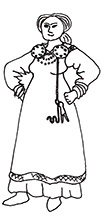Most keys with S-shaped bits have been found in women’s graves. In the Viking Era, women were buried with one or more personal items, such as jewelry, paste beads, brooches, bronze buckles, a knife, scissors, sewing needle, and so on.
 |
| A Viking-Era woman with key and scissors. Sketch by the author. |
Married women had an exalted, respected position in society. Upon marriage, the woman became the key bearer, responsible for the family’s treasures, and she wore the household’s keys on her dress as a symbol of her power. The keys hung in a highly visible location from her tool clasp, worn outside her clothes, or on a metal chain, a textile band, or a cord from one of her beautiful brooches. Often the keys hung with a small knife in a sheath, a small pair of scissors, or a sewing-needle holder.
Viking women and men were equals in body and spirit. Women were independent and self-assured, and of equal worth as men. But this relationship changed dramatically when Christianity came. The capable Viking woman had to step into the shadows; the first lady of the new religion was no liberated, vivacious Freja, but the desexualized Virgin Mary.
Motherhood was a natural part of a married woman’s life. On the farm, she was also responsible for thralls, the grain harvest, and the farm animals. She headed all religious ceremonies on the farm. She prepared animal skins and furs, and she was responsible for all the people on the farm, making sure they had clothing and food. She shaped and fired the clay cooking vessels and ensured that the sheep were shorn so that she could card and spin the wool. She oversaw the processing of flax and hemp, and the weaving and sewing of textiles. Without her, there would be no food or drink on the table. She also managed the farm’s surplus, safely locked away in chests and boxes.
People in the Viking Era loved bright colors. Women’s skirts or pinafores were colorful and fastened with shiny bronze brooches. In fact, brooches were not only decorative, but helped hold the Viking women’s skirts up. The women wore other polished bronze clasps pinned to their pinafores, and silver or bronze bracelets. The glass beads in their long necklaces were also multicolored.